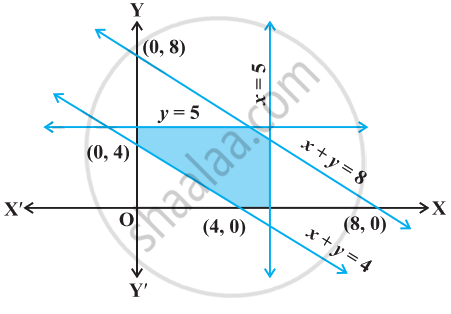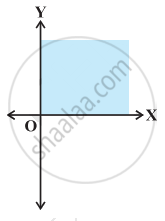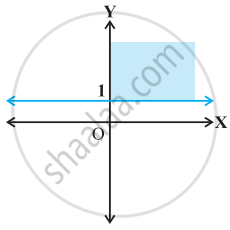Advertisements
Advertisements
Question
Write the solution set of the inequation \[\left| \frac{1}{x} - 2 \right| > 4\]
Solution
\[\text{ We have }: \]
\[\left| \frac{1}{x} - 2 \right| > 4\]
\[\text{ Here, two cases arise } . \]
\[\text{ CASE 1: When } \frac{1}{x} - 2 > 0, \text{ then } \left| \frac{1}{x} - 2 \right| = \frac{1}{x} - 2\]
\[ \therefore \frac{1}{x} - 2 > 4\]
\[ \Rightarrow \frac{1}{x} - 2 - 4 > 0\]
\[ \Rightarrow \frac{1}{x} > 6\]
\[ \Rightarrow x \in \left( 0, \frac{1}{6} \right) . . . (i)\]
\[\text{ CASE 2: When } \frac{1}{x} - 2 < 0, \text{ then } \left| \frac{1}{x} - 2 \right| = - \left( \frac{1}{x} - 2 \right)\]
\[ \therefore - \frac{1}{x} + 2 > 4\]
\[ \Rightarrow - \frac{1}{x} > 2\]
\[ \Rightarrow \frac{1}{x} < - 2\]
\[ \Rightarrow x \in \left( - \infty , \frac{- 1}{2} \right) . . . (ii)\]
\[\text{ Hence, the solution set of the given inequation is the union of (i) and (ii) }. \]
\[ \therefore x \in \left( - \infty , \frac{- 1}{2} \right) \cup \left( 0, \frac{1}{6} \right)\]
APPEARS IN
RELATED QUESTIONS
Solve the following system of inequalities graphically: x ≥ 3, y ≥ 2
Solve the following system of inequalities graphically: 3x + 2y ≤ 12, x ≥ 1, y ≥ 2
Solve the following system of inequalities graphically: 2x + y≥ 6, 3x + 4y ≤ 12
Solve the following system of inequalities graphically: x + y ≤ 6, x + y ≥ 4
Solve the following system of inequalities graphically: 2x + y≥ 8, x + 2y ≥ 10
Solve the following system of inequalities graphically: x + y ≤ 9, y > x, x ≥ 0
Solve the following system of inequalities graphically: 5x + 4y ≤ 20, x ≥ 1, y ≥ 2
Solve the following system of inequalities graphically: 3x + 4y ≤ 60, x + 3y ≤ 30, x ≥ 0, y ≥ 0
Solve the following system of inequalities graphically: x – 2y ≤ 3, 3x + 4y ≥ 12, x ≥ 0, y ≥ 1
Solve the following system of inequalities graphically: 4x + 3y ≤ 60, y ≥ 2x, x ≥ 3, x, y ≥ 0
Solve the following system of inequalities graphically: x + 2y ≤ 10, x + y ≥ 1, x – y ≤ 0, x ≥ 0, y ≥ 0
Find all pairs of consecutive odd positive integers, both of which are smaller than 10, such that their sum is more than 11.
Find all pairs of consecutive odd natural number, both of which are larger than 10, such that their sum is less than 40.
The marks scored by Rohit in two tests were 65 and 70. Find the minimum marks he should score in the third test to have an average of at least 65 marks.
To receive grade 'A' in a course, one must obtain an average of 90 marks or more in five papers each of 100 marks. If Shikha scored 87, 95, 92 and 94 marks in first four paper, find the minimum marks that she must score in the last paper to get grade 'A' in the course.
The longest side of a triangle is three times the shortest side and third side is 2 cm shorter than the longest side if the perimeter of the triangles at least 61 cm, find the minimum length of the shortest-side.
How many litres of water will have to be added to 1125 litres of the 45% solution of acid so that the resulting mixture will contain more than 25% but less than 30% acid content?
Write the set of values of x satisfying |x − 1| ≤ 3 and |x − 1| ≥ 1.
Write the number of integral solutions of \[\frac{x + 2}{x^2 + 1} > \frac{1}{2}\]
Write the set of values of x satisfying the inequations 5x + 2 < 3x + 8 and \[\frac{x + 2}{x - 1} < 4\]
Write the solution of set of\[\left| x + \frac{1}{x} \right| > 2\]
Write the solution set of the inequation |x − 1| ≥ |x − 3|.
Solve each of the following system of equations in R.
\[5x - 7 < 3\left( x + 3 \right), 1 - \frac{3x}{2} \geq x - 4\]
Find the graphical solution of the following system of linear inequations:
2x + 3y ≥ 12, – x + y ≤ 3, x ≤ 4, y ≥ 3
Find the graphical solution of the following system of linear inequations:
3x + 2y ≤ 1800, 2x + 7y ≤ 1400
Solve the following system of inequalities graphically.
2x – y ≥ 1, x – 2y ≤ – 1
Find the linear inequalities for which the shaded region in the given figure is the solution set.
Show that the following system of linear inequalities has no solution x + 2y ≤ 3, 3x + 4y ≥ 12, x ≥ 0, y ≥ 1
Solve the following system of linear inequalities:
3x + 2y ≥ 24, 3x + y ≤ 15, x ≥ 4
Show that the solution set of the following system of linear inequalities is an unbounded region 2x + y ≥ 8, x + 2y ≥ 10, x ≥ 0, y ≥ 0.
Solution set of x ≥ 0 and y ≤ 0 is
Solution set of x ≥ 0 and y ≤ 1 is
